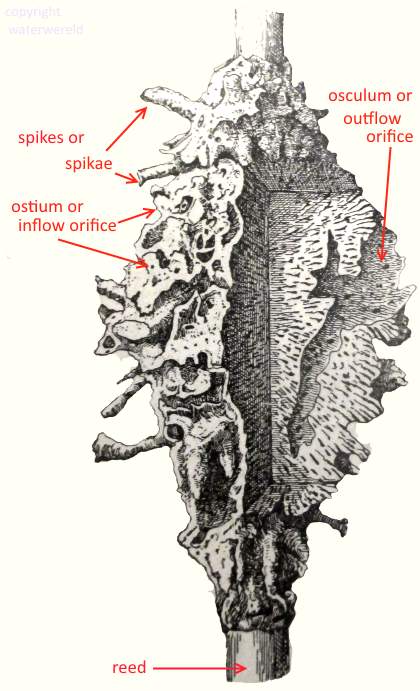freshwater sponge Spongilla lucastris
Spongilla lucastris is the most abundant fresh water sponge in central Europe.
It can be found under rocks and logs, covred from the sun. They can also grow on
reed. This sponge has a large distribution and can be found in Asia, Europe and the North American continent.
The color is mostly white but can have a greenish color because of symbiotic algae.
These freshwater sponges have irregularly scattered and barely visible water-exit holes.
The surface is uneven and roughened by small spicules.
live in a ditch:
1 two red watermites
2 Cristella mucedo, a a bryozoan.
3 Hydra
4 Piscicola, a leech.
5 Branchipus schaefferi, a fairy shrimp
6 Plumatella, a bryozoan.
7 Apus, a arthropod
8 Planorbis planorbis, a snail
9 Stickelback
10 spongilla lacustris
1 Duckweed
2 Frogbite
feeding of the freshwater sponge
The freshwater sponge is a filter feeder.
The freshwatersponge filters water that enters through the inlet, called ostium.
This incurrent pore is covered with a cell called porocyt 6 The water collects in a hole called spongocoel 2
The spongocoel is covered with cells that propels the water and feed on the plancton, these cells are called choanocyt, but mostly called collar cells.7
The filtered water leaves through the 5osculum.
There are free moving 3amebocyts that forms the spiculae 9, the skeleton of the sponge.
The large archeocytes will form the gemmelae.

The freshwater sponge anatomy.
reproduction
They have the capability to reproduce asexually and sexually. There are two ways of asexual reproduction: gemmelae forming during hibernation and bud forming.
Sexual reproduction happens in the summertime: the sponge gives birth to live larvae that are free swimming. The freshwater sponge is hermaphrodite: it produces both sperms and eggs.

hibernation and gemmulae
During the winter only one type of cell survives, these are called archeocytes.
These archeocytes are surrounded by a shell ,called a gemmulae.
The shell allows a high hydrostatic pressure to develop and thereby prevents osmotic rupture of the gemmula.
These gemmulae have many characteristis of an egg.
They are surrounded by an osmotic impermeabel membrame .
They are capable of surviving for long periods.
Inside the membrame there is an high osmotic pressure.
The other tissue of the freshwater sponge soon die.

1 Gemmelae during hibernation : the gemmelae is round 2 Gemmelae after hibernation : a young sponge leaves the gemmelae and starts a new animal.
the forming of buds
Buds are formed in the outer layer of the sponge. They drift awayand form a new colony.

The freshwater sponge Spongilla lucastris can be found attached to the underwater parts of reed, it has a greenish color because there are commensale algae in the outside parts. But it can also found under rocks, the color is whitish because of lack of sunlight.